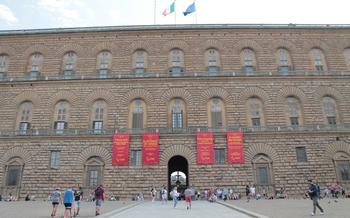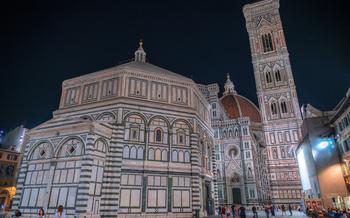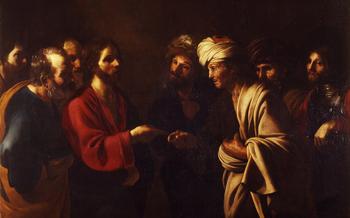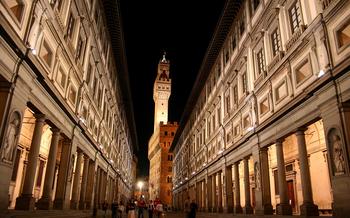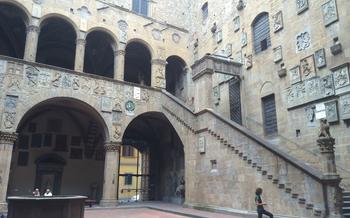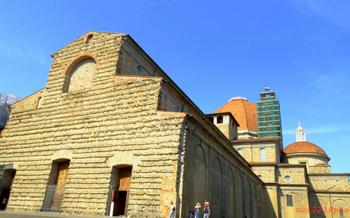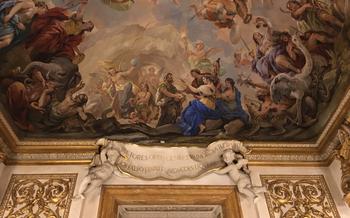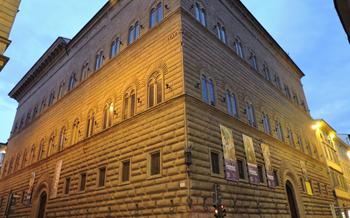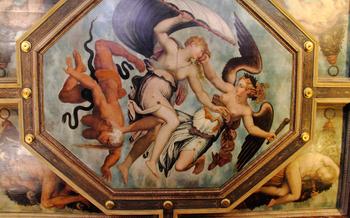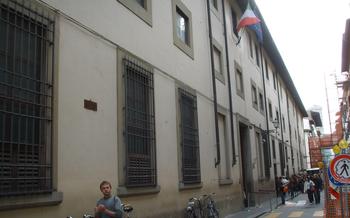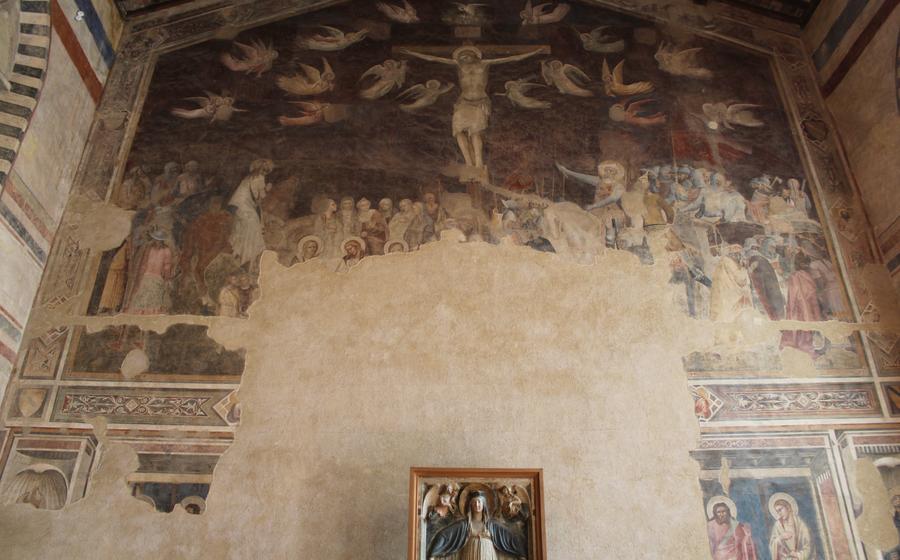
Cenacolo di Santo Spirito
- History of the Cenacolo di Santo Spirito
- Artistic Style
- Theories and Interpretations
- Restoration and Conservation
- Landmark Building
- Location
- Other Works to See in the Church
- Nearby Attractions
- Best Time to Visit
- Practical Tips for Visitors
- Interesting Anecdotes and Stories
- Insider Tip:
History of the Cenacolo di Santo Spirito
The Cenacolo di Santo Spirito his apostles. It was commissioned by the wealthy Florentine merchant Tommaso di Marco Strozzi, who wished to beautify and enhance the Church of Santo Spirito, a building with which he had close ties.
Andrea Orcagna, a prominent artist of the late Gothic period, was chosen to execute the fresco. Orcagna, the brother of the more famous painter Nardo di Cione, was known for his fresco cycles in the Strozzi Chapel of the Santa Maria Novella Church in Florence and the Loggia dei Lanzi on the Piazza della Signoria. His style, characterized by a combination of delicate Gothic naturalism and Byzantine influences, made him a suitable choice for this important commission.
Artistic Style
The Cenacolo di Santo Spirito is a masterpiece of the Gothic style, which dominated Italian art during the 13th and 14th centuries. Gothic art is characterized by its elongated figures, rich colors, and intricate details. The figures in Orcagna's fresco are tall and slender, with flowing robes. The colors are bright and vibrant, and the details are finely rendered.
Orcagna also uses symbolism and allegory in his painting. For example, the bread and wine on the table are symbols of the Eucharist, while the lamb is a symbol of Christ's sacrifice. The placement of Judas Iscariot, separate from the other apostles, symbolizes his betrayal of Christ.
Theories and Interpretations
The placement of Judas Iscariot in the painting has been the subject of various theories and interpretations. His isolation from the other apostles is seen as a symbol of his betrayal and separation from the group. Some believe that his position on the far right side of the table emphasizes his status as an outsider, while others suggest that it represents his separation from the community of believers.
Beyond Judas's placement, the painting is rich in symbolism and allegory. The objects and gestures depicted in the fresco carry hidden meanings and messages. For example, the loaf of bread and the wine on the table symbolize the Eucharist, while the hand gestures of Jesus and the apostles convey specific emotions and intentions. The positioning of the figures, the use of light and shadow, and the choice of colors all contribute to the overall meaning and message of the painting.
Scholars continue to study and analyze the Cenacolo di Santo Spirito, uncovering new insights and interpretations that add to our understanding of its artistic and historical significance.
Restoration and Conservation
The Cenacolo di Santo Spirito has undergone several restoration efforts throughout its history. One of the most significant restorations took place in the 19th century, when the fresco was cleaned and restored by the Italian painter and restorer Gaetano Bianchi. Bianchi removed layers of dirt and grime that had accumulated over the centuries, revealing the original colors and details of the painting. He also repaired and consolidated the plaster support.
In the 20th century, the Cenacolo was restored again, this time by the Opificio delle Pietre Dure, a Florentine conservation studio. The restorers focused on stabilizing the fresco's structure, consolidating the paint layer, and improving the overall appearance of the painting. They also removed some of the overpainting that had been added during previous restorations.
Fresco conservation is a complex and challenging process. Frescos are painted on wet plaster, which means that the colors are absorbed into the plaster and become part of the wall. This makes them very sensitive to changes in humidity and temperature. Restorers must take great care to ensure that the fresco is not damaged during the restoration process.
Thanks to the efforts of restorers, the Cenacolo di Santo Spirito has been preserved for future generations to enjoy. The fresco is now in good condition and can be seen by visitors from all over the world.
Landmark Building
The Cenacolo di Santo Spirito is housed within the walls of the Basilica of Santo Spirito, a stunning example of Renaissance architecture. Commissioned by the Florentine Republic in the 15th century, the church was designed by Filippo Brunelleschi, one of the most influential architects of the Renaissance.
With its harmonious proportions and innovative use of geometric principles, Santo Spirito represents a departure from the Gothic style that dominated Florentine architecture at the time. The church features a spacious nave, elegant side chapels, and a grand dome, all of which contribute to its majestic and awe-inspiring presence.
The exterior of the church is characterized by its simplicity and elegance. The austere facade is adorned with Corinthian pilasters and a circular window, echoing the classical ideals that inspired Brunelleschi's architectural vision.
Inside, visitors are greeted by a vaulted ceiling supported by tall, slender columns. The airy and luminous interior is enhanced by the natural light that floods in through the large windows, creating a serene and contemplative atmosphere.
Santo Spirito is not only a testament to Brunelleschi's architectural genius but also a treasure trove of Renaissance art. In addition to the Cenacolo, the church is home to numerous other notable works of art, including frescoes by Filippo Lippi, Perugino, and Andrea del Sarto.
Together, the Cenacolo di Santo Spirito and the Basilica of Santo Spirito form a remarkable architectural and artistic ensemble, offering visitors a glimpse into the rich cultural heritage of Florence during the Renaissance period.
Location
The Cenacolo di Santo Spirito is situated on the left bank of the Arno River, in the Oltrarno quarter of Florence, within the complex of the Basilica di Santo Spirito. To reach it, one can take a pleasant stroll through the heart of the Oltrarno, starting from Piazza Pitti, with its majestic Palazzo Pitti. Crossing the Ponte alla Carraia, one can admire the picturesque views of the river and the surrounding hills.
Turning right onto the Via Maggio, a vibrant street lined with shops and cafes, one will find the entrance to the Cenacolo on the left, just before the basilica. For those who prefer public transportation, the nearest bus stop is "Santo Spirito", served by lines 11, 36, and CParking in the area can be challenging, especially during peak tourist season, so it is advisable to use public transportation or park in one of the nearby garages, such as the Parcheggio della Fortezza or the Parcheggio Oltrarno.
Other Works to See in the Church
The church of Santo Spirito, as a prominent religious and cultural center in Florence, houses several other noteworthy works of art and architectural elements that are worth exploring. Here are some highlights to look for during your visit:
-
Filippo Brunelleschi's Architecture: Santo Spirito showcases the architectural genius of Filippo Brunelleschi, who designed and built the church in the 15th century. His innovative use of geometry and perspective creates a sense of harmony and balance throughout the building's interior.
-
Cappella Corbinelli: The Cappella Corbinelli, located to the left of the main altar, is an exquisitely decorated chapel designed by Giuliano da Sangallo. The chapel features a highly detailed altarpiece by Raffaello da Montelupo and striking frescoes by Cosimo Rosselli, depicting scenes from the life of Saint John the Baptist.
-
Chiostro Grande: The Chiostro Grande, or the large cloister, is a charming and peaceful courtyard adjacent to the church. Designed by Brunelleschi, the cloister features a series of columns and arches, creating an elegant and serene space for contemplation.
-
Museo di Santo Spirito: The Museo di Santo Spirito, housed within the former sacristy, showcases a collection of religious artifacts, vestments, and artworks from the church's history. The museum offers a glimpse into the rich artistic and religious heritage of the church and the Augustinian order.
-
Other Frescoes and Paintings: In addition to the Cenacolo di Santo Spirito, the church features several other notable frescoes and paintings, including works by renowned artists such as Francesco Botticini, Niccolò di Pietro Gerini, and Bartolomeo della Gatta. These artworks depict various religious scenes and figures, enriching the visual experience of the church.
Nearby Attractions
The Cenacolo di Santo Spirito is situated in the heart of Florence, within easy walking distance of numerous other notable attractions. One can conveniently combine a visit to the Cenacolo with exploring the surrounding area.
A short stroll away is the Palazzo Pitti, a grand ducal palace with extensive gardens, the Boboli Gardens. The Palazzo Pitti houses several museums, including the Gallery of Modern Art and the Museum of Costume and Fashion.
Another nearby attraction is the Ponte Vecchio, a medieval bridge renowned for its shops and goldsmiths. The bridge offers picturesque views of the Arno River and the surrounding cityscape. It's a must-see for any visitor to Florence and provides a delightful backdrop for capturing memorable photos.
For those interested in art and history, the Uffizi Gallery is a must-visit. It is one of the oldest and most famous art museums in the world, showcasing masterpieces by renowned artists such as Michelangelo, Raphael, and Leonardo da Vinci.
Feel like getting lost in a maze of medieval streets and piazzas? Head to the Oltrarno district, just across the river from the Cenacolo. This vibrant neighborhood boasts an eclectic mix of artisan workshops, boutiques, and trattorias, offering a glimpse into the authentic Florentine way of life.
Best Time to Visit
The best time to visit the Cenacolo di Santo Spirito is in the morning, when the natural light illuminates the fresco and enhances its colors and details. The church opens at 9:30 am, so arriving early is recommended to avoid crowds and have a more contemplative experience. On Sundays, the church may be busier due to religious services, so planning a visit on a weekday is advisable.
To avoid crowds, it's best to steer clear of peak tourist seasons, which typically fall during the summer months (June to August) and major holidays. Consider visiting in the shoulder seasons (April-May and September-October) when the weather is still pleasant, and there are fewer tourists.
Practical Tips for Visitors
- Photography Policy and Restrictions:
Photography is permitted inside the Cenacolo di Santo Spirito, but it is essential to be mindful of other visitors and the sanctity of the space. Flash photography is not allowed, and tripods and selfie sticks are generally not permitted. While admiring the fresco, visitors are encouraged to focus on the moment and appreciate the artwork's beauty without distractions.
- Accessibility for Visitors with Disabilities:
The church of Santo Spirito is accessible to visitors with disabilities. There is a ramp leading to the entrance, and the interior is wheelchair-friendly. Wheelchairs are available for rent on a first-come, first-served basis. Visitors with disabilities should not hesitate to ask for assistance from the church staff, who are always ready to assist.
Interesting Anecdotes and Stories
The Cenacolo di Santo Spirito, as a significant religious and cultural landmark, is intertwined with various legends, tales, and historical events that contribute to its mystique. One captivating anecdote involves the painter Andrea Orcagna himself. Legend has it that while working on the fresco, Orcagna faced a peculiar challenge. As he attempted to depict Judas Iscariot, the apostle responsible for betraying Jesus, he found himself unable to capture the appropriate expression for the figure. In an act of frustration, Orcagna is said to have thrown his paintbrush at the wall, leaving a mark that is still visible today. Whether this story is true or not, the mark remains a testament to the passion and intensity with which Orcagna approached his work.
Another intriguing incident occurred during the Napoleonic Wars when the invading French forces occupied Florence. An officer, seeking shelter from the cold, lit a fire to warm himself inside the Cenacolo. The fire's heat and smoke caused extensive damage to the fresco, resulting in significant losses to the original paint. The restoration efforts that followed proved arduous, with experts working tirelessly to repair the damaged portions while preserving the integrity of Orcagna's masterpiece.
These anecdotes and stories, passed down through generations, add layers of fascination to the Cenacolo di Santo Spirito, making it a site not only of artistic significance but also of historical intrigue.
Insider Tip:
For a unique perspective on the Cenacolo di Santo Spirito, venture to the church's sacristy, where a small window offers a rare glimpse of the work from a different angle. From this vantage point, you can appreciate the intricate details and vibrant colors of the fresco up close, gaining a fresh perspective on Orcagna's masterpiece.
